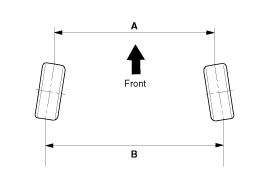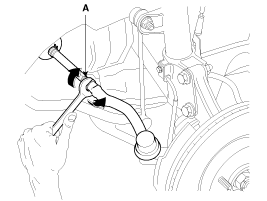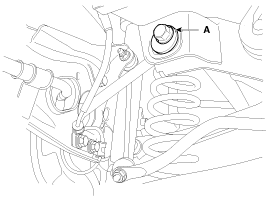 Kia Sportage: Alignment: Repair procedures
Kia Sportage: Alignment: Repair procedures
Third generation SL (2010ŌĆō2016) / Kia Sportage SL Service & Repair Manual / Suspension System / Tires/Wheels / Alignment: Repair procedures
| Front Wheel Alignment |
When using a commercially available computerized wheel
alignment equipment to inspect the front wheel alignment, always
position the vehicle on a level surface with the front wheels facing
straight ahead.
Prior to inspection, make sure that the front suspension and
steering system are in normal operating condition and that the tires are
inflated to the specified pressure. |
Toe

B - A > 0: Toe in (+)
B - A < 0: Toe out (-) |
Toe adjustment
| 1. |
Loosen the tie rod end lock nut. |
| 2. |
Remove the bellows clip to prevent the bellows from being twisted. |
| 3. |
Adjust the toe by screwing or unscrewing the tie rod. Toe
adjustment should be made by turning the right and left tie rods by the
same amount.
|
| 4. |
When completing the toe adjustment, install the bellows clip and tighten the tie rod end lock nut to specified torque.
|
| 5. |
Compensate the steering angle sensor after adjusting the wheel alignment.
(Refer to Steering System - "Steering Column-Shaft") |
Camber and Caster
Camber and Caster are pre-set at the factory, so they do not
need to be adjusted. If the camber and caster are not within the
standard value, replace or repair the damaged parts and then inspect
again.
Camber angle : -0.5┬░┬▒0.5┬░ |
Caster angle : 4.02 ┬░ ┬▒ 0.5┬░ |
| Rear Wheel Alignment |
When using a commercially available computerized wheel
alignment equipment to inspect the rear wheel alignment, always position
the vehicle on a level surface.
Prior to inspection, make sure that the rear suspension
system is in normal operating condition and that the tires are inflated
to the specified pressure. |
Toe

B - A > 0: Toe in (+)
B - A < 0: Toe out (-) |
Toe adjustment
| 1. |
Loosen the nut holding the assist arm cam bolt (A). |
| 2. |
Adjust rear toe by turning the rear assist arm cam bolt (A)
clockwise or counter clockwise. Toe adjustment should be made by turning
the right and left cam bolt by the same amount.
|
| 3. |
When completing the toe adjustment, tighten the nut to specified torque.
|
| 4. |
Compensate the steering angle sensor after adjusting the wheel alignment.
(Refer to Steering System - "Steering Column-Shaft") |
Camber
Adjust the camber by turning the cambolt of the rear lower arm.
Camber: -1.0┬░┬▒0.5┬░ |
| Cam bolt | Turning direction | Toe |
| LH (Driver''s side) | Clockwise | Camber - |
| Counter clockwise | Camber + | |
| RH | Clockwise | Camber + |
| Counter clockwise | Camber - |
 Wheel: Repair procedures
Wheel: Repair procedures
Hub nut tightening sequence
Tighten the hub nuts as follows.
Tightening torque :
88.3 ~ 107.9N.m (9.0 ~ 11.0kgf.m, 65.1 ~ 79.6lb-ft)
When using an impact gun, fi ...
Other Information:
Overdrive Clutch Control Solenoid Valve(OD/C_VFS): Specifications
Specifications
Direct control VFS[OD/C]
? Control type : Normal high type
Control Pressure kpa (kgf/cm?, psi)500.14 ~ 9.81 (5.1 ~ 0.1, 72.54 ~ 1.42)Current value(mA)50 ~ 850 Internal resis ...
To defrost outside windshield
1.Set the fan speed to the highest position.
2.Set the temperature to the extreme hot (HI) position.
3.Press the defroster button ().
4.The outside (fresh) air position will be selected automatic ...
Categories
- Home
- Kia Sportage QL (2015-2019) Owners Manual
- Kia Sportage QL (2015-2019) Service Manual
- Kia Sportage SL 2010-2016 Owners Manual
- Kia Sportage SL 2010-2016 Service Manual
Copyright ® www.kispmanual.com 2014-2025




